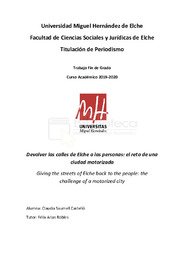Por favor, use este identificador para citar o enlazar este ítem:
https://hdl.handle.net/11000/27257Registro completo de metadatos
| Campo DC | Valor | Lengua/Idioma |
|---|---|---|
| dc.contributor.advisor | Arias Robles, Félix | - |
| dc.contributor.author | Saumell Castelló, Claudia | - |
| dc.contributor.other | Departamentos de la UMH::Ciencias Sociales y Humanas | es_ES |
| dc.date.accessioned | 2022-05-20T11:05:31Z | - |
| dc.date.available | 2022-05-20T11:05:31Z | - |
| dc.date.created | 2020-06-15 | - |
| dc.identifier.uri | http://hdl.handle.net/11000/27257 | - |
| dc.description.abstract | El descubrimiento del carbón como combustible en el siglo XVIII generó un problema que la sociedad lleva a sus espaldas hasta hoy: la contaminación y el cambio climático. Por suerte, la solución para disminuir la contaminación en las ciudades es simple, reducir el uso de vehículos. Los puntos de más contaminación en Elche se concentran en lugares donde el tráfico es muy elevado y donde los edificios no permiten que el aire circule y se renueve. Por ello, el Ayuntamiento ha planeado medidas para aliviar los puntos más perjudicados y crear una ciudad más sostenible y amable con la movilidad ecológica. Con la llegada del Estado de Alarma provocado por la pandemia mundial de la COVID-19, las concentraciones de NO2 descendieron hasta un 64% en Elche y un 70% en la provincia de Alicante, alcanzando mínimos históricos. Esta crisis sirvió para aliviar los niveles de contaminación y para proponer nuevos modelos de movilidad, más actualizados y seguros para ciclistas y peatones con un objetivo, que la ciudad vuelva a ser para las personas y menos para los vehículos. | es_ES |
| dc.description.abstract | The discovery of coal as a fuel in the 18th century created a problem that society has been carrying on with to this day: pollution and climate change. Fortunately, the solution to reduce pollution in cities is simple: reduce vehicle use. The points of most pollution in Elche are concentrated in places where the traffic is very high and where the buildings do not allow the air to circulate and be renewed. Therefore, the City Council has planned measures to alleviate the most affected points and create a more sustainable and eco-friendly city. With the arrival of the State of Alarm caused by the global pandemic of COVID-19, NO2 concentrations fell by 64% in Elche and 70% in the province of Alicante, reaching historic lows. This crisis served to alleviate pollution levels and to propose new models of mobility, more up-to-date and safer for cyclists and pedestrians with the aim of making the city once again for people and less for vehicles. | es_ES |
| dc.format | application/pdf | es_ES |
| dc.format.extent | 37 | es_ES |
| dc.language.iso | spa | es_ES |
| dc.publisher | Universidad Miguel Hernández de Elche | es_ES |
| dc.rights | info:eu-repo/semantics/openAccess | es_ES |
| dc.rights.uri | http://creativecommons.org/licenses/by-nc-nd/4.0/ | * |
| dc.subject | contaminación | es_ES |
| dc.subject | movilidad | es_ES |
| dc.subject | transporte | es_ES |
| dc.subject | Covid-19 | es_ES |
| dc.subject | vehículos | es_ES |
| dc.subject | pollution | es_ES |
| dc.subject | mobility | es_ES |
| dc.subject | transport | es_ES |
| dc.subject | vehicles | es_ES |
| dc.subject.other | CDU::0 - Generalidades.::070 - Periódicos. Prensa. Periodismo. Ciencias de la información | es_ES |
| dc.title | Devolver las calles de Elche a las personas: el reto de una ciudad motorizada | es_ES |
| dc.title.alternative | Giving the streets of Elche back to the people: the challenge of a motorized city | es_ES |
| dc.type | info:eu-repo/semantics/bachelorThesis | es_ES |

Ver/Abrir:
TFG-Saumell Castelló, Claudia.pdf
1,97 MB
Adobe PDF
Compartir:
 La licencia se describe como: Atribución-NonComercial-NoDerivada 4.0 Internacional.
La licencia se describe como: Atribución-NonComercial-NoDerivada 4.0 Internacional.
.png)